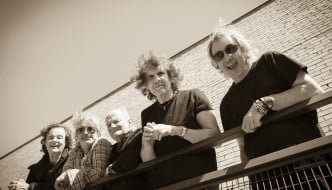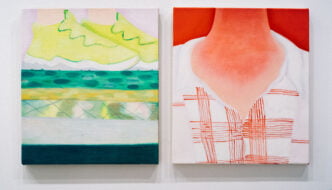Review: Painting In Time at The Tetley
May 4, 2015
[Sarah Kate Wilson-Zumba ]
Painting as performative compositions to be rearranged; painting anthropomorphised with IKEA furniture legs and placed on hinges to be interacted with; painting forbidding the materiality of paint from drying; painting produced by machines as live events; painting that continues to metamorphose having left the studio; painting as do-it-yourself activities with instructions and diagrams; painting as implicitly gestural, accumulating dust and dirt; painting as ephemeral, created in situ and destroyed upon the completion of the exhibition; painting inflating and deflating, activated by movement and time-based switches; painting through evaporation; painting within the digital screen of the technological realm; painting as ‘momentary conclusions’, freestanding and potentially stacked.

[Claire Ashley-Another Tasteless Hunk]
This sense of hybridity or perhaps ‘coalition’ seems to be the ‘in thing’ at the moment. But fear not, for the ‘creative coalitions’ being discussed here shouldn’t leave you feeling bitterly cheated and nearly thirty thousand pounds in debt. Painting in Time, co-curated by Sarah Kate Wilson and Zoe Sawyer, proposes a reconfiguration and re-assessment of the role, functionality and process of painting, and its location within contemporary practice.
For residents of the art world, the desire to expand practice and adopt progressive modes of making and thinking is a very natural thing.
Undoubtedly for others it is considerably less so. Ideologically speaking, painting is arguably one of the most universally understood modes of art making. Painting in Time amplifies a consideration of painting as a time-based medium; works which continue to unfold and expand upon their (initial) completion at the studio, defying conceptions of painting as a static object. Most intriguing here however are works that create some sense of evolving development of their own accord, or by more specific modes of engagement such as mechanical, temporal or other technological modes of involvement. The notion of mindless interaction through simply touching, rearranging or moving something is beginning to feel increasingly insignificant, particularly when one considers the more forward-thinking (or expansive) opportunities for engagement that participatory has pursued since the sixties or the developments of relational art practices throughout the early nineties. But again, for those more comfortable and familiar with the optical experience of painting, this is a significant advancement and an important way into the expanded field of painting. Particularly following the famously dynamic Jerwood Drawing Prize, The Tetley are undeniably satisfying their endeavour to captivate a wide and varied audience with an alluring test-site environment of experimental practice.

[Jessica Warboys-Box Painting]
There is much to be discussed with regards to hybridity and expansive practice in considering its critical reception. Have we reached a point of outgrowing the titles of painting, sculpture, drawing etc? Once titles, are they now more of a mentality or contextual setting? Sarah Kate Wilson discusses that whilst dialectical arguments of ‘is it a painting or it isn’t a painting’ are not particularly useful in that they simply form cul-de-sac avenues of thought, they are nonetheless necessary or useful anchors; lighthouses in vast churning seas of imponderability. They gravitate our thoughts and tether them to a lineage of art history, forming nuclei for our continued cogitation. Yet as a result of this and the preconceptions tied to them, they can also spawn caution and hinder intellectual autonomy, particularly with respect to more traditionally-rooted agendas.

[Image courtesy of bookofcool.com]
Artist Ian Kiaer, whose work is often regarded as having a relationship to painting without necessarily referencing its ideological qualities, discussed in a recent interview the “troubled terms of painting and sculpture”. Shortly before his 2014 show Tooth House at the Henry Moore Institute in Leeds, he described a deliberate resistance to such titles, opting instead to refer to his work “in terms of a ‘project’ to try and avoid these rooted definitions”. Keeping HMI in mind, the similarities between their recent project The Event Sculpture and Painting in Time are voluminous. Both amplify a rhizomatic critique of the static object from the perspectives of expanded sculpture and painting. Could the contents of each show be switched? And if so, what does this say about the value of each? Interestingly several of the artists included within Painting in Time do not consider their work to be associated with ‘painting’. Is painting in time as a notion merely a curatorial gel here, or has it re-appropriated disparate investigations through collaborative conversation to propose something exciting and new?
Perhaps we’ve reached that cul-de-sac.
The Tetley fosters an experimental platform that situates itself between the finished gallery environment and the test-site space or ‘springboard’ for new and engaged work. Importantly, through an impressive range of both emerging and established artists, the selected work and the conversations surrounding it brings the expanded field of painting and couples it with this ethos. The days of solely static painting locked in and governed by Greenbergean anxieties of opticality are long behind us. Painting as expressed here is about inquisitive interrogations and creative potentiality, and it’s about time.
Dan Newton
Painting In Time: 3rd April – 5th July 2015
Filed under: Art & Photography
Tagged with: exhibition, painting, Painting In Time, review, The Tetley



Comments